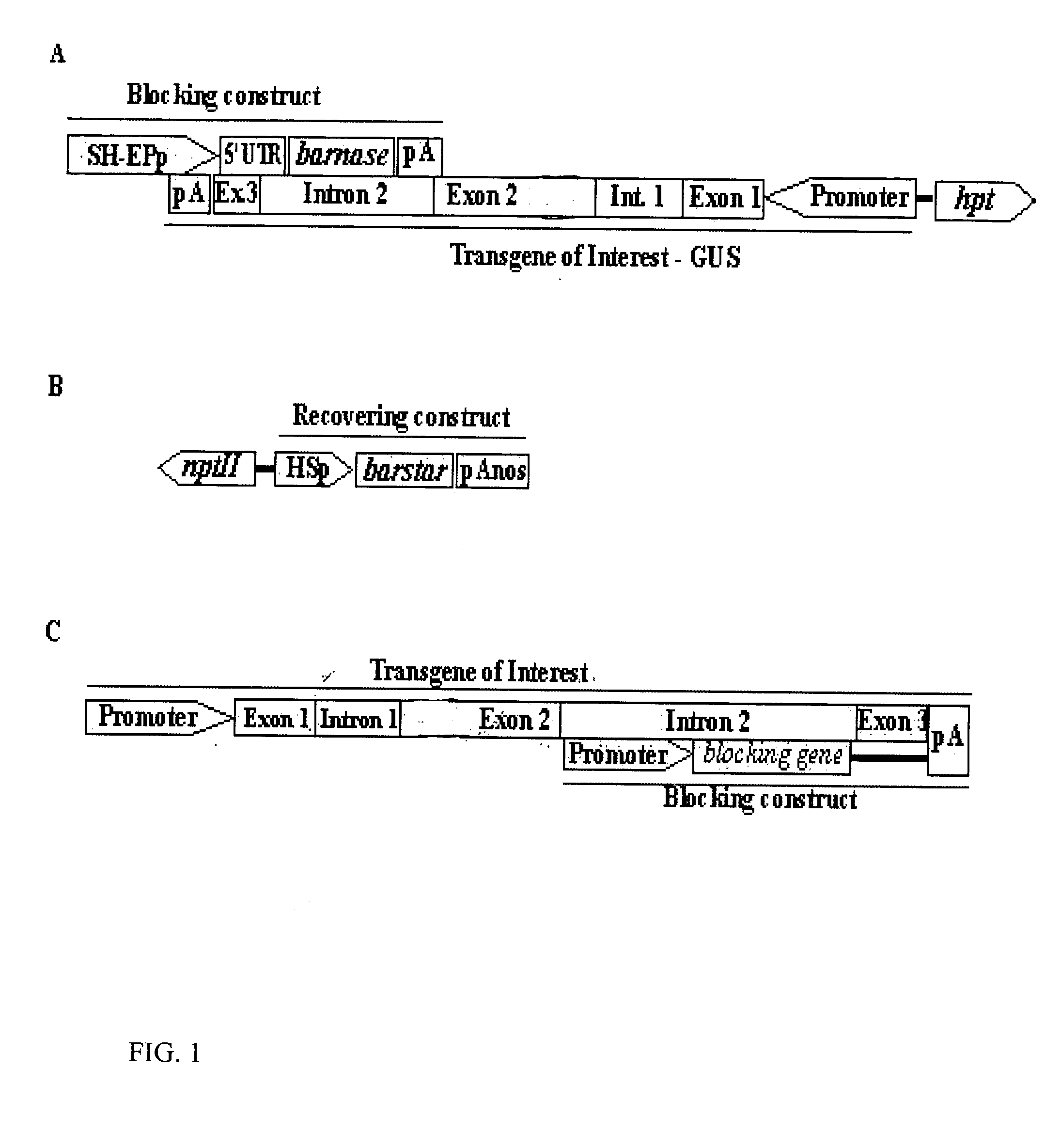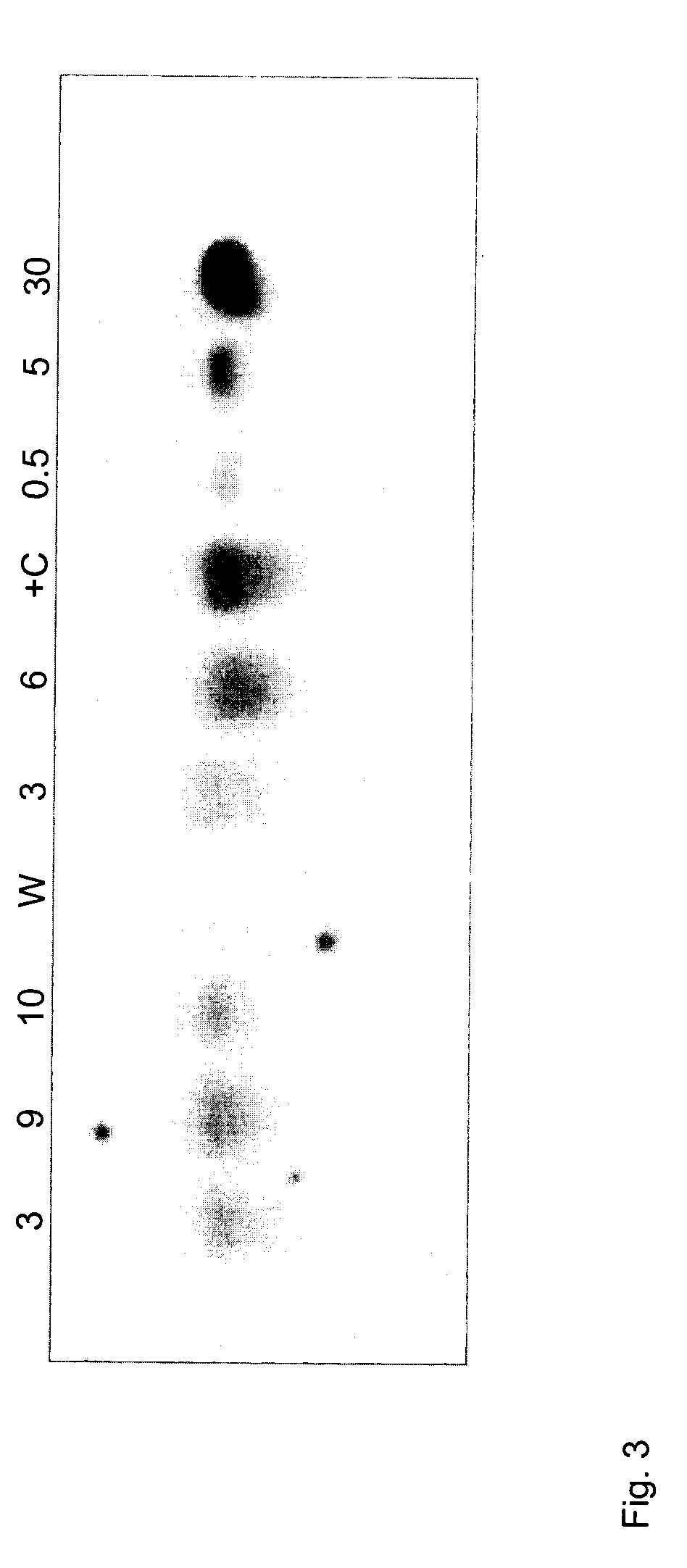Molecular mechanims for gene contaiment in plants
a technology of molecular mechanims and plants, which is applied in the field of molecular mechanisms for gene contaiment in plants, can solve the problems that bc expression leads to the death or incapacity of sexual reproduction of plants, and achieve the effect of reducing the negative effect of barnas
- Summary
- Abstract
- Description
- Claims
- Application Information
AI Technical Summary
Benefits of technology
Problems solved by technology
Method used
Image
Examples
example 2
Design of the Intron Cassette
[0075] In this specific example we designed the Intron cassette so that barnase (BC) and GUS (TGI) genes are transcribed in opposite directions with respect to each other (FIG. 1A). Barnase coding sequence (SEQ ID NO: 1) was placed in the intron of GUS gene (FIG. 2). GUS gene was split in position 49 nucleotides upstream the stop codon. CGC codon of arginine has been changed to AGG to form splicing site between the two guanidines. Six nucleotides before the splicing site, a glutamine codon was changed from CAA to CAG to form a PstI restriction site. The sequence CGCTTTTCTG (SEQ ID NO: 8) upstream the PstI site was changed to TGCCTTCCTG (SEQ ID NO: 9) to introduce an additional alternative cleavage site for polyadenylation and to increase the GC content in the close vicinity of the intron. Restriction site PstI and the minor changes upstream of it were introduced by PCR amplification of GUS gene sequence using long 5' primer containing the modifications d...
example 3
A Segregating Type of RBF having an Intron Cassette with Organ Specific Expression of BC and Inducible Expression of TGI
[0077] In order to achieve a segregating type of RBF we developed a DNA construct, where BC is situated in the intron of TGI and the RC is inserted in a different chromosome (FIG. 1a and b). The segregating RBF provides control for TGI containment after the RC segregates apart the construct carrying the TGI and the BC. After RC segregates apart, expression of the BC prevents the reproduction of plants carrying the TGI linked with BC. BC was placed under an organ-specific promoter, which in this example was cysteine endopeptidase (SH-EP) from Vinga mungo. Other organ-specific promoters could be used as well. A functional example of other promoters is Crusiferine promoter from Brassica napus.
[0078] In this example the RC was regulated by heat shock promoter of Glycine max, and thereby the RBF was heat shock inducible. Other heat shock promoters or could be used as we...
example 4
Bacteria and Plant Transformation
[0082] Escherichia coli strain XL1 was used for the cloning of the DNA constructs.
[0083] Leaf segments of tobacco plants (Nicotiana tabacum) cv. Samsung were inoculated with suspension of A. tumefaciens strain LBA4404 carrying the pGPTV-HPT and pGPTV-NPT binary vectors, which are based on pBIN19. Putative transformants were selected on 30 mg / l hygromycin or 75 mg / l kanamycin. The RC construct was transferred first and positive lines as revealed in Northern analysis (FIGS. 3 and 4) were re-transformed with the TGI containing the coding sequence of BC in its last intron. Selection of lines with successful second transformation was made on the basis of GUS and Northern analyses (FIG. 5). Positive lines were transferred to the greenhouse for further studies.
EXAMPLE 5
Analysis of Gene Expression
[0084] The gene expression assays were based on histological GUS assays. Fresh leaf materials were frozen in liquid nitrogen and then pulverizes into fine powder. T...
PUM
| Property | Measurement | Unit |
|---|---|---|
| Time | aaaaa | aaaaa |
| Time | aaaaa | aaaaa |
| Time | aaaaa | aaaaa |
Abstract
Description
Claims
Application Information
 Login to View More
Login to View More - R&D
- Intellectual Property
- Life Sciences
- Materials
- Tech Scout
- Unparalleled Data Quality
- Higher Quality Content
- 60% Fewer Hallucinations
Browse by: Latest US Patents, China's latest patents, Technical Efficacy Thesaurus, Application Domain, Technology Topic, Popular Technical Reports.
© 2025 PatSnap. All rights reserved.Legal|Privacy policy|Modern Slavery Act Transparency Statement|Sitemap|About US| Contact US: help@patsnap.com



